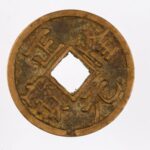Coin Taihe tongbao
A round copper alloy coin with a square hole in the centre, called fangkong qian 方孔錢. These appeared in various denominations, mostly as tongbao 通寶 (“common currency”) coins, which were worth one monetary unit, yuanbao 元寶 (“original currency”) and zhongbao 重寶 (“heavy currency”) which had higher denominations. In many varieties and denominations, such coins had been in circulation as standard money since the time of Emperor Gaozu 高祖 (reigned 618–626), the first emperor of the Tang Dynasty (618–907) until the end of the Qing Dynasty (1644–1912). The inscription on the coin usually consists of two characters, reading from top to bottom, indicating the name of the reign or the period in which the coin was minted. The other two characters are to be read from right to left. On the left-hand side of the coin is usually the character bao 寶 (wealth, preciousness), which in combination ... more
A round copper alloy coin with a square hole in the centre, called fangkong qian 方孔錢. These appeared in various denominations, mostly as tongbao 通寶 (“common currency”) coins, which were worth one monetary unit, yuanbao 元寶 (“original currency”) and zhongbao 重寶 (“heavy currency”) which had higher denominations. In many varieties and denominations, such coins had been in circulation as standard money since the time of Emperor Gaozu 高祖 (reigned 618–626), the first emperor of the Tang Dynasty (618–907) until the end of the Qing Dynasty (1644–1912). The inscription on the coin usually consists of two characters, reading from top to bottom, indicating the name of the reign or the period in which the coin was minted. The other two characters are to be read from right to left. On the left-hand side of the coin is usually the character bao 寶 (wealth, preciousness), which in combination with the character on the right means “currency” or “money in circulation”. This is usually the character tong 通 (circulate, be uniform, general or universal), but often alsoyuan 元 (origin, basis) or zhong 重 (weight), which usually denote coins with a larger face value. Thus, the entire inscription literally means “money in circulation at the time of this or that emperor” or “in this or that period of a single emperor’s reign”.
The coin shown is from the state of Jin 金 (1115–1234), founded in north-eastern China in 1115 by the Jurchens (Nüzhen 女真), the ancestors of the later Manchus (Manzu 油成) who founded the last imperial Qing Dynasty (1644–1912). After attacking and defeating the Song 宋 Dynasty (960–1279) in 1127 and forcing the Chinese court to flee to the south, they reigned the entire north until their state was overthrown by the Mongols in 1234. Due to the poor availability or lack of copper ore in the area, Song Dynasty coins were often in circulation; from 1158 a small quantity of Jin coins began to be minted, though mostly exactly in the style of Song coins. This coin is the so-called Taihe tongbao 泰和通寶, which reads from top to bottom and from right to left, and has characters written on the obverse in elaborate seal script or zhuanshu 篆書. It was minted during the reign of Emperor Zhangzong 章宗 (reigned 1190–1209), during the period of his reign called Taihe 泰和 (1204–1209), meaning “supreme harmony”. (MG)







































Do you have a comment or additional information about the subject?